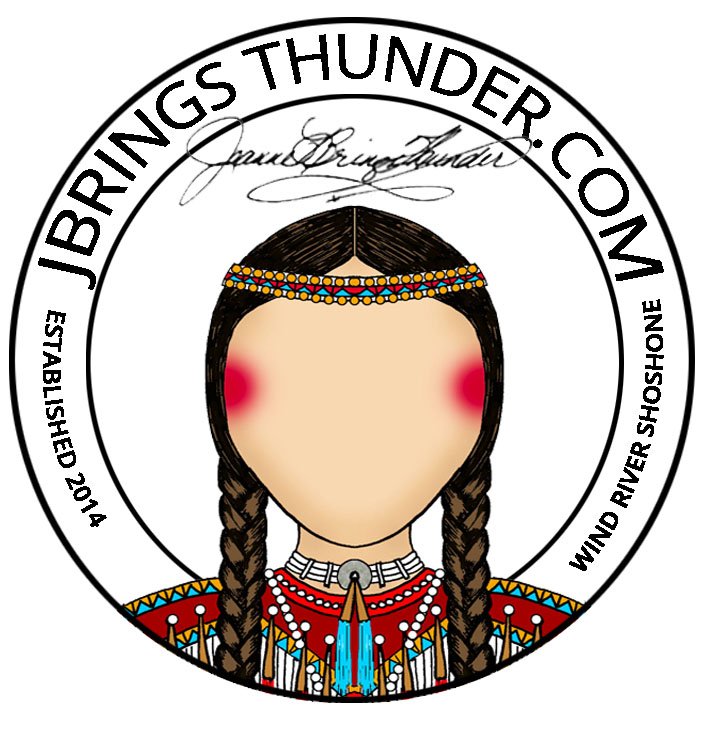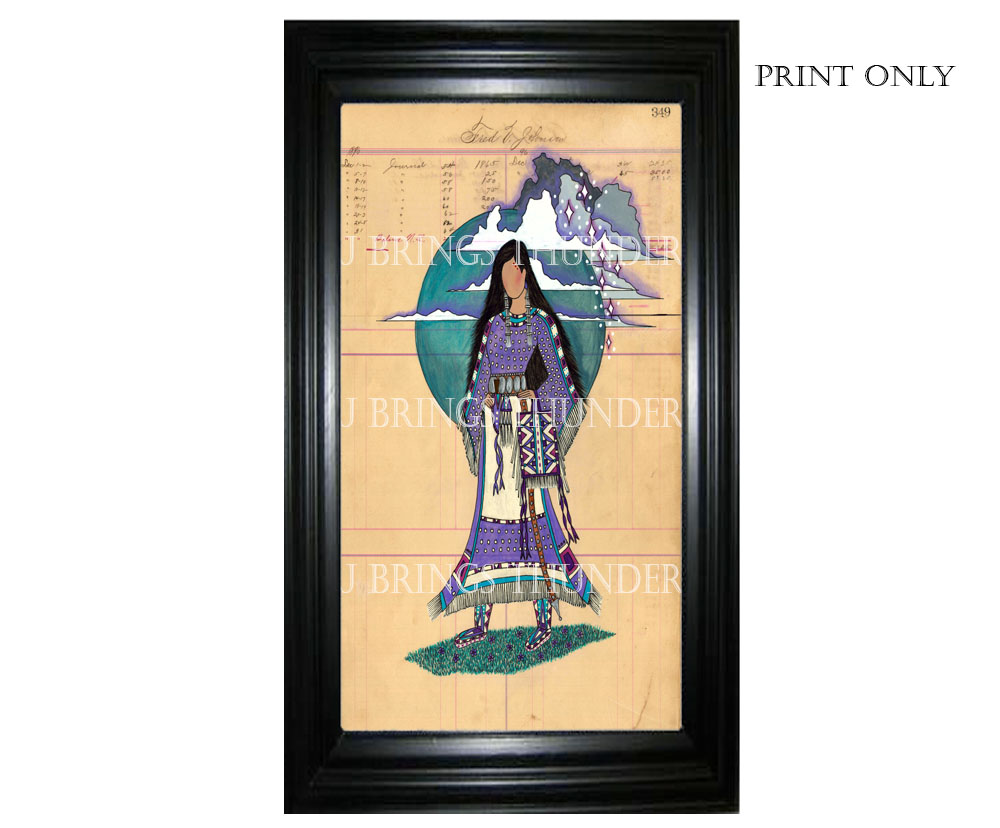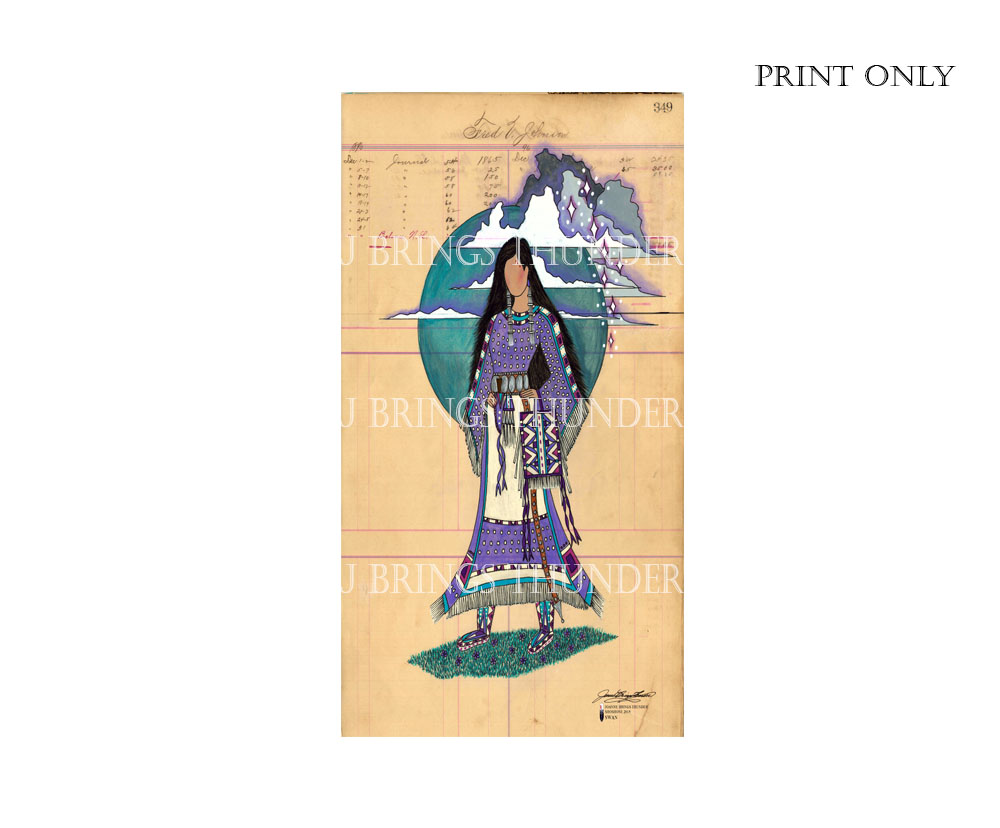The Greatest Love Story Of All Time - The Sun & The Moon




The Greatest Love Story Of All Time - The Sun & The Moon
39.00
***PRINT ONLY***
The Greatest Love Story Of All Time - The Sun & The Moon 2020
Mixed Media : Ledger Paper, Acrylic, Ink
Dimensions: 11”x17”
Original Ledger 1810
By: Joanne Brings Thunder
The Greatest Love Story of All Time
The Sun and the Moon
My favorite love story is how the Sun loved the Moon so much, he died every night to let her breathe…
The Sun is a powerful spirit. His light is so powerful it actually brought plants to life from the ground but few know that plants were actually the idea of the moon. Everyone, every day, comes to
honor him but not the moon.
The Moon was seen as a dark spirit. One that brought a cold presence to the land and the people. Everyone hid in their lodges when she rose.
The Moon craved to be seen. She wanted a breath of fresh air up in the night sky, her only friends where the stars and water. She wanted to be loved. Yet everyone admired the Sun. They sensed
the warmth of his glow. They felt alive in his daylight.
But the Sun had a deep secret: he secretly loved the Moon. He recognized her humble glow and fell for the way she carried herself despite her invisibility compared to him. She hid parts of herself from
the land and the people that he knew they should recognize and embrace because her secret qualities could benefit them.
They were opposite spirits, the Sun and Moon. They were lovers who rarely met and always missed one another. Yet they both waited patiently for the rare mornings and evenings when they might
coexist peacefully, together in the sky.
The Sun wanted to make his true love happy in his absence. He wanted to show the land and the people what she had to offer.
He thought for weeks about how to give her the breath of air she wanted while letting the land and the people feel her magic and honor her as they do him. Finally he knew what he had to be done. He sacrificed his light every night so the moon could be seen in all her beauty.
He gave up something he was admired to let her shine.
Ledger Art History
This genre, often called Ledger Art, represents a transitional form of Plains Indian artistry corresponding to the forced reduction of Plains tribes to government reservations, roughly between 1860 and 1900. Due to the destruction of the buffalo herds and other game animals of the Great Plains by Anglo-Americans during and after the Civil War, painting on buffalo hide gave way to works on paper, muslin, canvas, and occasionally commercially prepared cow or buffalo hides.
Changes in the content of pictographic art, the rapid adjustment of Plains artists to the relatively small size of a sheet of ledger paper, and the wealth of detail possible with new coloring materials, marks Plains ledger drawings as a new form of Native American art. As such, ledger painting portrays a transitional expression of art and material culture that links traditional (pre-reservation) Plains painting to the Plains and Pueblo Indian painting styles that emerged during the 1920s in Indian schools in Oklahoma and New Mexico.
Beginning in the early 1860s, Plains Indian men adapted their representational style of painting to paper in the form of accountants ledger books. Traditional paints and bone and stick brushes used to paint on hide gave way to new implements such as colored pencils, crayon, and occasionally water color paints. Plains artists acquired paper and new drawing materials in trade, or as booty after a military engagement, or from a raid. Initially, the content of ledger drawings continued the tradition of depicting of military exploits and important acts of personal heroism already established in representational painting on buffalo hides and animal skins. As the US government implemented the forced relocation of the Plains peoples to reservations, for all practical purposes completed by the end of the 1870s, Plains artists added scenes of ceremony and daily life from before the reservation to the repertoire of their artwork, reflecting the social and cultural changes brought by life on the reservation within the larger context of forced assimilation.
Copyright
All content including the presentation thereof on this web site is the property of Joanne Brings Thunder and protected by U.S. and international copyright laws. You may not copy, reproduce, distribute, transmit, modify, create derivative works, or in any other way exploit any part of copyrighted material without the prior written permission from Joanne Brings Thunder.










